Central and South Gippsland
Next on our figure-of-eight tour of Victoria, we visited Central and South Gippsland.
Central Gippsland
So, after leaving Cape Conran in East Gippsland, we travelled to Sale in Central Gippsland for an overnight stay. The town has some reasonable accommodation and restaurant options. Moreover, we left early morning to drive to Meeniyan in South Gippsland, visiting Tarra Bulgar National Park. The direct route from Sale to Tarra Bulga National Park Visitor Centre is around 80 kilometres. However, we approached the park from Yarram, following the scenic route from the south.
Tarra Valley River and Falls
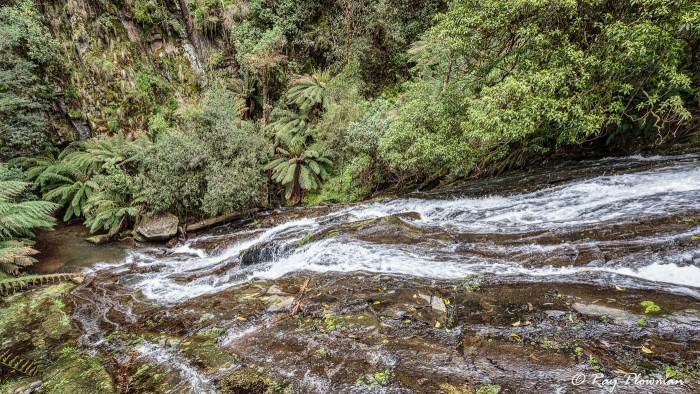
Upper Tarra Falls
Upper Falls in the Tarra Valley, Tarra Bulgar National Park, Central Gippsland.
[foogallery id=”17934″]
The Tarra Valley Road (C484) from Yarram is initially two-way but narrows as it makes its way through the rainforest. Further, the road crosses the Tarra River a couple of times on wooden paved bridges. So, we stopped at one bridge to explore and photograph the river. Then we continued to Tarra Valley Falls, parked on a roadside pull-off. It is a short walk to the upper and lower falls. After Tarra Falls, we drove to Tara Valley Picnic Area and Carpark for the Rainforest Walk.
Tarra Valley River and Falls
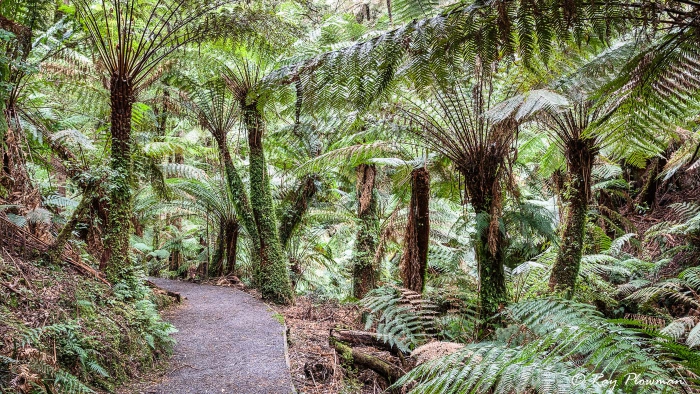
Soft Tree Ferns
Soft Tree Ferns (Dicksonia antarctica) growing in the Tarra Valley Rainforest, Central Gippsland.
[foogallery id=”17935″]
A 1.4 km easy-going party circular walk through the rainforest under a canopy of tree ferns and ancient myrtle beech. It is a track with wooden bridges across streams and steps on the steeper sections. Moreover, the cool temperate rainforest is part of the Tarra Bulga National Park.
Ancient Myrtle Beech (Nothofagus cunninghamii) is native to Southern Victoria and Tasmania. The photo shows a very-old root system, possibly 1,000 years old. The gallery also features a tributary of the Tarra River and Cyathea Falls with a drop of some 10 metres. And the dominant fern species in the gully are soft tree ferns (Dicksonia antarctica), native to eastern Australia and Tasmania. Although, there are a couple of rarer species. Mountain Ash also features in the landscape.
After the walk, we continued north to the Tarra-Bulga National Park Visitor Centre.
Tarra-Bulga National Park
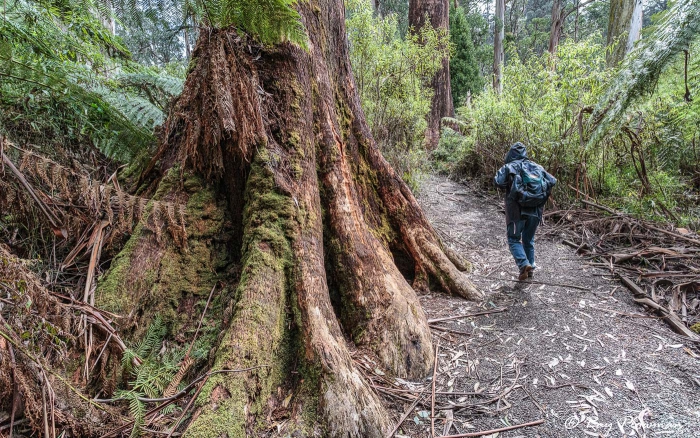
Massive Mountain Ash
A massive Mountain Ash (Eucalyptus regnans) at Scenic Track walk in Tarra Bulga National Park, Central Gippsland
[foogallery id=”17952″]
Tarra Bulga National Park has several walking tracks starting from the Visitor Centre. So, we decided to take a circular 3 km walk to Corrigan Suspension Bridge.
We took the Lyrebird Track from the Visitor Centre; then, after 600 m, we turned onto Ash Track for another 600 m. These tracks passed through regenerating mountain ash (Eucalyptus regnans) forest and with some mature trees reaching 75 m tall. Mountain ash is native to south-eastern Australia.
Next, we turned right onto Wills Track leading to the Corrigan Suspension Bridge. There is a magnificent view of Fern Tree Gully from the bridge. Home to rough-tree-ferns (Cyathea australis), native to south-eastern Australia and typically grow to 12 m.
After crossing the bridge, we followed the Scenic Track for about 1000m back to the Visitor Centre. There are several massive old mountain ash trees along this track close to the path.
We set off from the Visitor Centre mid-afternoon to drive 100 km to Meeniyan in South Gippsland for a two-night stay.
South Gippsland
Towns with hotel/motel accommodation and restaurants seem limited in rural areas near Wilson Promontory. So Meeniyan was a good place as it was just a half-hour drive to the park entrance. Moreover, it allowed an entire day to visit the Prom without too much driving on the day.
Wilsons Promontory National Park
The park has an abundance of nature activities for day visitors, including trails, beaches and lookouts. Tidal River is the central visitor hub with a visitor centre, general store, camping ground and other self-catering options. Unfortunately, no restaurants in the area.
Four galleries below display: landscape, wildlife and nature highlights from our day visit. The first gallery features Squeaky Beach, Lookouts and Birds at Prom Wildlife Walk. Second, nature images from Lilly Pilly Gully Walk. The third gallery displays landscape and wildlife at Lilly Pilly Link Track. Finally, the fourth landscape and native birds at Tidal River, Loo-Ern Walk and the Footbridge.
Squeaky Beach, Lookouts and Birds at Prom Wildlife Walk
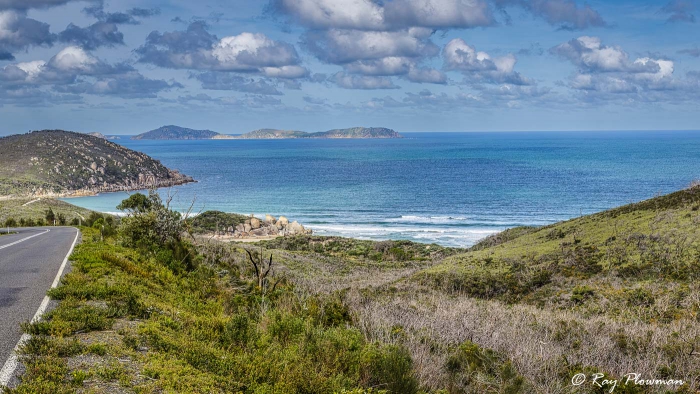
Wilsons Promontory
Vista of the peninsula and offshore granite islands at Wilsons Promontory National Park in South Gippsland
[foogallery id=”17957″]
On entering the park, the road to Tidal River goes through bushland. Then, thirteen kilometres from the entrance is a small grassy area, the start of the Prom Wildlife Walk. So, we stopped here on the way to and from Tidal River. Many long-billed corellas with sulphur-crested cockatoo flew around; featured images include emu and long-billed corella. We continued the drive south; the road eventually opened with vistas of the Prom and offshore granite islands. On the way back, we explored several beaches, including the Squeaky Beach and Glennie Lockout.
Nature Images at Lilly Pilly Gully Nature Walk
[foogallery id=”17966″]
Next, we stopped at Lilly-Pilly Gully carpark for the nature walk. A leisurely 2.6 km walk, returning the same way or 5.2 km on the circular trail. We took the shorter walk.
The single image below shows a native Yellow Admiral (Vanessa itea) butterfly feeding on tick bush (Kunzea ambigua) nectar.
![Yellow Admiral (Vanessa itea) [Australian admiral] feeding on flower nectar at Wilson Promontory in Victoria State](https://rayplowman.co.uk/wp-content/uploads/2021/02/Yellow-Admiral-_AU_5213dhgf-700x560.jpg)
The gallery displays some of the spring native wildflowers growing along the track. Most featured flora are common species found in the Southeast, with some species also in Queensland and South Australia. A notable exception is broad-leaf prickly moses (Acacia verticillata ruscifolia), a Tasmanian subspecies with similar specimens in Wilson’s Promontory area. The gallery shows a prickly moses (Acacia verticillata) nominate species for comparison. Also, the pink form of common heath is the Victoria State Floral Emblem
Landscapes and Wildlife at Lilly Pilly Link Track
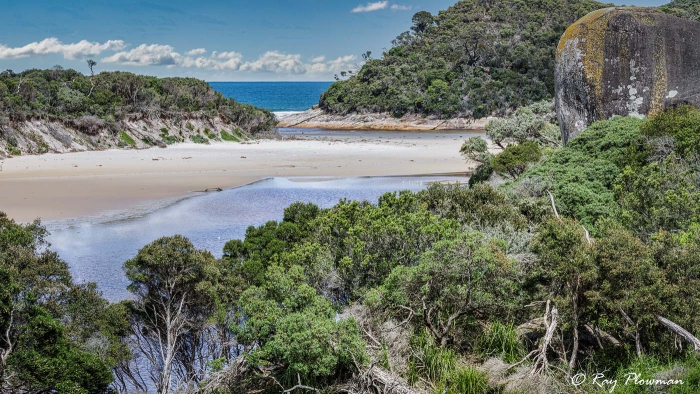
Tidal River Estuary
Tidal River Estuary from Lilly Pilly Link Track at Wilsons Promontory National Park in South Gippsland.
[foogallery id=”17967″]
Lilly Pilly Link Track starts from the river’s north bank, accessed by crossing the bridge from Loo-Ern Track. We followed the trail to the viewpoint then returned to the Tidal River footbridge. Next, a short excursion on the tidal overlook circuit to the whale rock viewpoint (Ref 1) before returning. The following gallery features an image of whale rock from the footbridge. There are some magnificent views of the river and coast; also, flora and fauna on the tails. The gallery displays Loo-Errn Boardwalk, a common fringe-lily, an immature male superb fairy-wren, and a sulphur-crested cockatoo.
Tidal River, Loo-Ern Walk and the Footbridge
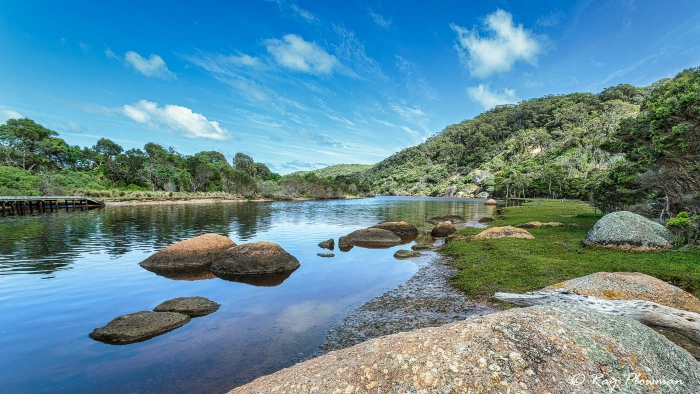
Tidal River
Tidal River at Wilsons Promontory National Park in South Gippsland.
[foogallery id=”17972″]
Tidal River is the centre of activities in Wilsons Prom, with many short and day walks (Ref 1). Our first walk was the Loo-Ern Track for river and coast vistas. Further, it is a flat 500 m boardwalk along the river’s south bank. The gallery features a tree landscape of the north bank that depicts the steepness of the bank. And birds in the area where the track meanders its way to a bridge: a rather wet looking native grey butcherbird, a welcome swallow and a native red wattlebird. Moreover, the Tidal River has brown water caused by tannin released from the decomposing vegetation.
Continue the 2013 Tour of Victoria
We drove from Meeniyan in South Gippsland to Melbourne; ‘Next’ to continue to Central and South Gippsland webpage.
Or ‘VIC’ to go to the Nature and Wildlife in Victoria, Australia webpage.
References – Online Resources
1. Trails at Wilsons Promontory. No date. [Online] Available from https://www.alltrails.com/ [Accessed 5-Marl-22].
Bibliography – Online Resources
1. Visit Central Gippsland. No date. [Online] Available from https://www.visitgippsland.com.au/ [Accessed 5-Marl-22].
2. Tarra Bulga National Park. No date. [Online] Available from https://www.parks.vic.gov.au [Accessed 5-Marl-22].
3. Friends of Tarra-Bulga National Park. 2022. [Online] Available from http://friendsoftarrabulga.org.au/ [Accessed 5-Marl-22].
4. Visit South Gippsland. No date. [Online] Available from https://www.visitgippsland.com.au/ [Accessed 5-Marl-22].
5. Wilsons Promontory National Park. No date. [Online] Available from https://south-gippsland.com/ [Accessed 5-Marl-22].